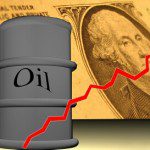When the idea of high oil prices comes to mind, one quickly recalls the hot months of 2008, when crude prices got to nearly $150 a barrel. How did we get back here so quickly and why are prices likely to stay put?
2008, when crude prices got to nearly $150 a barrel. How did we get back here so quickly and why are prices likely to stay put?
The above introductory comments are edited excerpts from an article* by Jens Erik Gould (thefinancialist.com) entitled Why Triple Digit Oil Is the ‘New Normal’.
The following article is presented courtesy of Lorimer Wilson, editor of www.munKNEE.com (Your Key to Making Money!), and www.FinancialArticleSummariesToday.com (A site for sore eyes and inquisitive minds) and has been edited, abridged and/or reformatted (some sub-titles and bold/italics emphases) for the sake of clarity and brevity to ensure a fast and easy read. This paragraph must be included in any article re-posting to avoid copyright infringement.
Gould goes on to say in further edited excerpts:
…Last month, the five-year rolling average price of Brent crude topped $100 a barrel for the first time ever. Worse yet, Credit Suisse energy commodity analyst Jan Stuart doesn’t think another reprieve is in the cards. He calls the current price level “a new normal.”
Demand
On the demand side, it’s quite simple. Both the global economy as well as global population continue to grow, and along with them demand for fossil fuels. Global oil demand has fallen only two times in the past two decades: the height of the global financial crisis in 2008 and 2009. Global consumption should increase by 1.4 million barrels a day, or 1.5 percent, to a record 92.7 billion a day in 2014, according to the International Energy Agency, which raised its forecast in March as the economic recovery gained momentum.
Supply – Production
For its part, supply is not keeping up with demand. While U.S. production has grown substantially thanks to shale drilling, the U.S. is the only major non-OPEC nation posting significant production increases. All-in, last year’s oil consumption grew by 1.4 million barrels a day, while production only increased 560,000 barrels a day, according to the BP Statistical Review of Energy.
Supply – Geopolitcs
As has been the case since the start, the main threat to oil supply is geopolitics. “The instability in the Middle East and North Africa is so fundamental that it’s going to take a very long time for it to become a stable place for the oil industry,” says Stuart. In the meantime, production has fallen by a total of 3.5 million barrels a day, according to Credit Suisse.
1. Increasing sectarian violence in Iraq, for example, has once again put the 150 billion barrels of proven oil reserves of OPEC’s second-largest producer into question, in the process helping to push the price of Brent to a high of $115.19 on June 19.
Back in 2009, expectations were high: New investment by foreign oil companies was going to double Iraq’s output to 5 million barrels a day by 2013 and further increase it to 8 million by 2019. And that, in turn, would account for some 60 percent of OPEC’s overall production increase through decade’s end. We’re nearly halfway through the decade, however, and production remains at the same level it was in 2009—2.5 million barrels a day. Brent prices have dipped back below $110, and the current spasm of violence hasn’t reached the oil producing south, but companies including ExxonMobil and BP have begun evacuating employees, and investors are worried that continued violence could render even more modest production forecasts a pipe dream.
Iraq is just one example of many. The wave of political uprising, exuberantly (and prematurely) coined the “Arab Spring”, has left oil supply problems in its wake nearly everywhere it has rolled through.
2. Protests that began last summer in Libya, which holds Africa’s largest reserves, cut output to around 350,000 barrels a day from the 1.4 million barrels a day the country was producing last year, although the country recently restarted production at its El Sharara field, which will hopefully bring 340,000 barrels a day back online after a four-month strike by protesters.
3. In South Sudan, fighting between the president and his former deputy has cut output by roughly one-third to around 160,000 barrels a day since December.
4. Conflicts in Syria and Yemen have also cut output.
The ‘New Normal’
Last month, Credit Suisse raised its forecast for average Brent prices in 2014 and 2015 to $110.64 and $102.50 from $107.03 and $97.50, respectively….
Every $10 a barrel increase in oil prices reduces real U.S. income growth by as much as 0.4 percent, according to Credit Suisse estimates.
“We are worried about the political events in the Middle East,” says James Sweeney, chief economist for Credit Suisse’s investment bank. “A meaningful shock in oil could really disturb a lot of our cyclical outlook.”
Editor’s Note: The author’s views and conclusions in the above article are unaltered and no personal comments have been included to maintain the integrity of the original post. Furthermore, the views, conclusions and any recommendations offered in this article are not to be construed as an endorsement of such by the editor.
*https://www.thefinancialist.com/why-triple-digit-oil-is-the-new-normal/ (© Copyright 2014 Credit Suisse)
Follow the munKNEE!
- Register for our Newsletter (sample here)
- Find us on Facebook
- Follow us on Twitter (#munknee)
- Subscribe via RSS
Related Articles:
1. What Would Likely Occur If Oil Rose to $140+ In Today’s Hyper-leveraged Global Economy?
With the Middle East now lurching towards yet another major war, it’s easy to envision a supply disruption that sends oil back to its previous high or beyond. So the question becomes, what would that do to today’s hyper-leveraged global economy? Bad things, obviously. Here are just 4 things that would likely happen. Read More »
2. Could a World of $7,000 Gold, $100 Silver & $400 Oil Be Coming?
Jim Rickards explains in his new book “The Death of Money – The Coming Collapse of the International Monetary System” why a US dollar collapse could be coming and why gold would probably emerge at the heart of a new global monetary system as the only money that you can really trust. Read More »
3. Invested in the S&P 500? Then Watch Price of WTI Crude Oil Closely – Here’s Why
For the past few years West Texas Intermediate Crude (WTIC) oil and the S&P 500 have trended together and have hit key highs and lows around the same time window. WTIC is now within 1% of the top of its multi-year pennant pattern which has brought on short-term S&P 500 corrections. What does that mean for the future direction of the S&P 500 this time round? Read More »
 munKNEE.com Your Key to Making Money
munKNEE.com Your Key to Making Money


